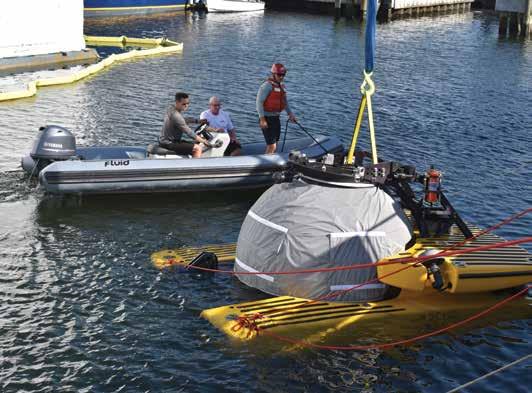
4 minute read
Living and traveling with a submarine
Living and traveling with a sub A yacht captain’s reflections as a pilot
By Lucy Chabot Reed
Capt. Les Annan didn’t think his musings about working and living with a submarine would generate much interest. His family and friends asked lots of questions, so in an effort to avoid having to repeat himself, he started posting updates about his job as pilot of a personal Triton 3300/3 submersible on his Facebook page.
But beyond that?
“There was no reason or rationale to why I started it,” he said, noting that the first submarine post went up this summer. “It’s just nice to post something that’s apolitical. It’s kind of hard to get upset about subs.”
But only his friends and family could see his blog posts there, along with posts of his sons’ accomplishments and other personal thoughts.
So Capt. Annan launched a public page in late June, and after just a few days, it had already got more than 160 members. By mid-September, it was nearly 400.
The first thing to know about the blog is that it’s pretty technical. Capt. Annan – in addition to being 3000-ton all oceans master – is also a chief engineer of unlimited tonnage and unlimited horsepower. (He’s also been diving since he was 12 and is a PADI master dive instructor.)
So his posts are full of technical interactions with the sub, detailing its systems, its batteries, ABS certification, even polishing the props.
But there’s more, including videos of the sub in action, on the surface and underwater. Capt. Annan also shares personal thoughts. Here’s a snippet from Les’s Submarine Blog No. 7:
“What goes through the mind of a sub pilot?
“I can only speak of what I think about, but I am sure that other pilots have the same thoughts.
“Driving the sub is easy and very intuitive but there is a lot on the mind of the pilot. The system information
Capt. Les Annan applies his knowledge as a captain, chief engineer and now sub pilot to his Facebook blog. At right, he is driven to the sub his crew just launched. TRITON FILE PHOTOS

given to the pilot is clear and easy to understand. The waterproof, wifi, wireless tablet is monitoring and recording the sub systems and will alert the pilot if something needs attention. The pilot has the best seat in the sub and has a huge range of unblocked vision and comfort. Most systems have a backup and some have a backup to the backup.
“This is what I am thinking in the sub:”, which is followed by more than 25 questions he asks himself, such as Is there a current? and Am I close enough to the wall?
And after scuba diving for most of his life, here are his thoughts from Blog #11:
“One of the first things that changed for me is what deep means underwater. For a scuba diver on air, 40m is very deep. For a Navy submarine, 300m is deep. For me, now 900m is deep and 75m is shallow. I have been told less than 500 people in the world have been below 500m.
“There is a theory that the giant squid (up to 13m) travel the world below 500m. So far, two giant squid have been seen underwater from a Triton sub. Most places we go with the sub, we are the first ones to sub dive there so once you are below 40m you are the first human to see whatever you see.”
Capt. Annan has more than 30 years working on what he calls “white boats”, and a stint working as chief engineer of a 320-foot offshore support vessel in the oil and gas field when the yachting industry slowed down during the Great Recession.
When he came back to yachting about four years ago, he helped a broker and took a temporary assignment as chief engineer on M/V Axis, the 182foot Damen support vessel to M/Y Gigi, a 164-foot (50m) Westport.
“They liked me and I liked them and they asked me to stay,” he said.
When the captain hired for Axis fell through, Capt. Annan took the post.
When it came time to outfit the vessel with a sub, the owner asked what sort of person would make a good sub pilot. The sub maker said the pilot should be a captain, be a diver, and know a bit about engineering.
“Well, that’s Les,” the owner said. So Capt. Annan and the captain of Gigi were both trained as sub pilots.
And he’s been enjoying it ever since. One day last week, he went down on three dives of 200m. His deepest has been 1000m. “That’s the limit of the sub,” he said, as if to leave the door open for even deeper dives.
He has noted that exploration of the deep ocean is all being done by private funding. And the government-created charts aren’t accurate.
“But do they really care where the 100m drop-off is?” he said. “But me, I’m looking for the wall. That’s where the sea life is. There’s a lot of life and a lot of color there.
“That’s what we do, go down and look at fish. You can’t get out, but the boss and his guests love it.”

Lucy Chabot Reed is publisher of The Triton. Comments are welcome at lucy@ the-triton.com.











